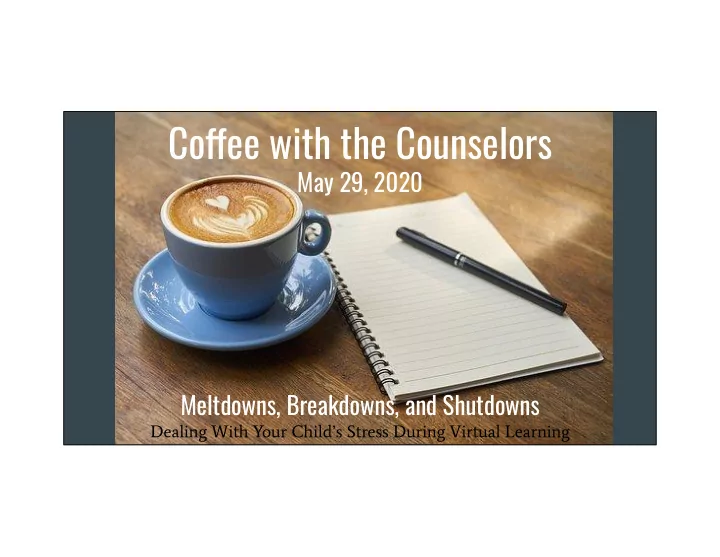

Cofgee with the Counselors May 29, 2020 Meltdowns, Breakdowns, and Shutdowns Dealing With Your Child’s Stress During Virtual Learning
Tantrums vs. Meltdowns, Breakdowns, & Shutdowns Tantrum Meltdown, Breakdown, & Shutdown ● manipulation ● being overwhelmed, having anxious feelings, or system is breaking down knowing what they are doing ● it is a message that they need ● a choice ● something or one of their needs is not being met
Possible Current Stressors for Children and Youth Loss of family members or ● ● Loss of activities and plans someone they know Isolation from friends ● Lack of access to normal ways of ● Increased stress in the home ● dealing with stress Change of routines ● Increased responsibilities at home ● Uncertainty and lack of control ● Being home alone or without ● ● Academic stress and pressure adult Restriction ● COVID-19 Fears ● Family or friends sick ● Loss of transitions and closure ● Fear of someone getting sick ● Loss of rights of passage ● Changes in emotions and ● Racial bias ● motivation There are a lot!
How Youth May Respond to Stress **Not all youth respond in same way -- watch for changes in your child Excessive crying or irritation for younger students ● Returning to behaviors they have outgrown ● Excessive worry or sadness ● Unhealthy eating or sleeping habits ● Irritability and “acting out” behaviors in pre-teens or teens ● Poor school performance or avoiding school (saying they are doing work when they are ● not) Difficulty with attention and concentration ● Avoidance of activities enjoyed in the past ● Unexplained headaches or body pain ●
What this could look like for younger students E motional or behavioral symptoms may include: Physical symptoms can include: · Anxiety, worry · Decreased appetite, other changes in eating habits · Not able to relax · Headache · New or recurring fears (fear of the dark or being alone, · New or recurrent bedwetting fear of strangers) · Nightmares · Clinging, unwilling to let you out of sight · Sleep disturbances · Anger, crying, whining · Upset stomach or vague stomach pain · Not able to control emotions · Other physical symptoms with no physical illness · Aggressive or stubborn behavior · Going back to behaviors present at a younger age · Doesn't want to participate in family or school activitie s
What this could look like for middle school students ● Saying negative things about themselves, others, the world around them Headaches, stomachaches, physical pains ● Avoidance/ignoring challenges or problems ● Behavioral changes ● Difficulty concentrating or focusing ● ● A change in school performance Difficulty sleeping or remaining asleep ● Mood swings (look for change in mood swings) ●
Creating Emotional and Physical Safety How Parents Can Help Their Children: How Parents Can Help Themselves: CONNECT Notice your behavior ● Show affection ● Notice your child’s behavior ● Practice breathing techniques ● ● Use a feelings chart ● Change your mindset / Rethink ● Cool down corner/area your thoughts CORRECT Pause & Plan ● ● Talk about what to do with the feeling Give choices ● Roleplay ● Model ● Create structure/routine when possible ● *HAVE REGULAR CHECK-IN TIMES!
Ways to Counter Common Stressors During COVID-19 Stressors: Isolation → identify opportunities to connect as family and with others Restriction (physically and emotionally) → create spaces to move, get active, laugh, check in on emotions, etc.. Academics → listen to what your child is feeling, work with them to create systems and give support they may need Lack of Control/Unknowns → create routines and clear expectations, focus on what you can control
Circles of Control What I can and cannot control during COVID-19
Language That Connects Observation and Curiosity ○ “I have noticed…”(specific observable behavior) ■ “I am curious about…” “I wonder …” ■ “I’m sensing that you are feeling overwhelmed by …., is that true?” ■ “You mentioned that... Can you tell me more about that” ■ ○ Validation and Reflection Capturing what they just shared - “you don’t know what to do next” ■ Being Real and Transparent ○ “I’m not sure what to do right now, but I will try my best to listen.” ■ ■ “I’m sorry that I yelled at you earlier. I shouldn’t have done that. Maybe we could talk together about what we could do differently tomorrow to help our morning go more smoothly.”
Q&A Click ‘Raise Your Hand’ in the Participants Box or write a question in the chat to ask a question. Please add to the chat any suggestions you have for the topic we should cover at our next Coffee with the Counselors. Thank you for joining us today!!
Recommend
More recommend